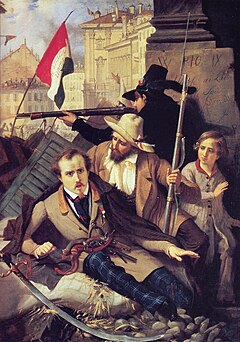
Back Unifikasie van Italië Afrikaans Risorgimento ALS توحيد إيطاليا Arabic Unificación d'Italia AST Risorcimento Azerbaijani Рысарджымента Byelorussian Рысарджымэнта BE-X-OLD Рисорджименто Bulgarian Risorgimento Breton Unificació italiana Catalan
 Five Days of Milan, 18–22 March 1848 | |
| Native name | Risorgimento |
|---|---|
| Date | 1848–1871 |
| Location | Italy |
| Participants | Italian society, Kingdom of Sardinia, Provisional Government of Milan, Republic of San Marco, Kingdom of Sicily, Roman Republic, Carboneria, French Empire, Redshirts, Hungarian legion, Southern Army, United Provinces of Central Italy, Kingdom of Italy |
| Outcome |
|
| History of Italy |
|---|
 |
|
|
The unification of Italy (Italian: Unità d'Italia, Italian: [uniˈta ddiˈtaːlja]), also known as the Risorgimento (/rɪˌsɔːrdʒɪˈmɛntoʊ/, Italian: [risordʒiˈmento]; lit. 'Resurgence'), was the 19th century political and social movement that in 1861 ended in the annexation of various states of the Italian peninsula and its outlying isles to the Kingdom of Sardinia, resulting in the creation of the Kingdom of Italy. Inspired by the rebellions in the 1820s and 1830s against the outcome of the Congress of Vienna, the unification process was precipitated by the Revolutions of 1848, and reached completion in 1870 after the capture of Rome and its designation as the capital of the Kingdom of Italy.[1][2]
Individuals who played a major part in the struggle for unification and liberation from foreign domination included King Victor Emmanuel II of Italy, Camillo Benso, Count of Cavour, Giuseppe Garibaldi, and Giuseppe Mazzini.[3] Borrowing from the old Latin title Pater Patriae of the Roman emperors, the Italians gave to King Victor Emmanuel II the epithet of Father of the Fatherland (Italian: Padre della Patria).[4] Even after 1870, many ethnic Italian-speakers (Italians in Trentino-Alto Adige/Südtirol, Savoyard Italians, Corfiot Italians, Niçard Italians, Swiss Italians, Corsican Italians, Maltese Italians, Istrian Italians, and Dalmatian Italians) remained outside the borders of the Kingdom of Italy, planting the seeds of Italian irredentism.
Italy celebrates the anniversary of the unification on 17 March (the date of proclamation of the Kingdom of Italy). Some of the states that had been envisaged as part of the unification process (terre irredente) did not join the Kingdom until after Italy defeated Austria-Hungary in World War I, culminating in the Treaty of Rapallo in 1920. Some historians see the Risorgimento as continuing to that time, which is the view presented at the Central Museum of the Risorgimento at Altare della Patria in Rome.[5][6]
- ^ Collier, Martin (2003). Italian unification, 1820–71. Heinemann Advanced History (First ed.). Oxford: Heinemann. p. 2. ISBN 978-0-435-32754-5.
The Risorgimento is the name given to the process that ended with the political unification of Italy in 1871.
- ^ Riall, Lucy (1994). The Italian Risorgimento: state, society, and national unification (First ed.). London: Routledge. p. 1. ISBN 978-0-203-41234-3.
The functional importance of the Risorgimento to both Italian politics and Italian historiography has made this short period (1815–60) one of the most contested and controversial in modern Italian history.
- ^ "Fratelli d'Italia, divisi su tutto" (in Italian). 12 December 2016. Retrieved 17 March 2021.
- ^ Cite error: The named reference
raiculturawas invoked but never defined (see the help page). - ^ Arnaldi, Girolamo. Italy and Its Invaders. Harvard University Press, 2005. p. 194. ISBN 0-674-01870-2.
- ^ "Museo Centrale del Risorgimento di Roma". Istituto per la storia del Risorgimento italiano (in Italian). Retrieved 6 July 2018.